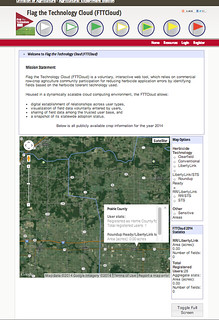‘Flag the Technology’ goes to the cloud
FLAG THE TECHNOLOGY -- A successful program rolled out in 2011, Flag the Technology leaps into the cloud with the help of Google Earth. (U of A System Division of Agriculture photo.)
Fast Facts:
- Flag the Technology moves into the cloud
- Secure login allows users to specify row crop acreage, sensitive areas such as fish ponds
- FTTCloud can be found at https://fttcloud.uada.edu.
(401 words)
LONOKE, Ark. – Flag the Technology is moving to the cloud to help aerial applicators avoid mismatching spray and crops in farm fields.
Flag the Technology, introduced statewide in 2011, was based on a simple premise: placing color-coded bicycle flags on corners of a field would provide a means for spray planes to know which field needed what herbicide. The idea took off with row crop growers in Arkansas, Missouri, Mississippi and Louisiana using the flags.
The new version, FTTCloud, is based on Google Maps and allows users to map out what crop technology they’re using on which row crop fields. Users can register, log in though a secure website, add information about their farms. Participation is voluntary.
Going to the cloud means “we can eliminate the need for physically placing flags in the field,” said Bob Scott, extension weed scientist for the University of Arkansas System Division of Agriculture.
“FTTCloud allow producers to digitally establish connections with their consultants, chemical applicators, and county agents,” said Dharmendra Saraswat, extension engineer for the Division of Agriculture. “Basic information, such as herbicide technology and location, about any new field is mailed to all registered users. Users can email, search, and print maps of the entered data. Non-registered users can also visualize countywide adoption status of the tool through user statistics included on the home page.”
Saraswat said that when producers begin classifying their acreage, in addition to “herbicide tolerant technologies, they can also identify sensitive areas such as orchards, pumpkin patches, fish ponds and other areas on their property.”
Arkansas county agents were trained in the use of the site in March.
“It’s definitely in a trial mode right now,” said Scott. “This is the first year and we want to see what kind of adoption we have.”
Although some farmers, herbicide and seed dealers might feel a little uncomfortable making private use decisions public, getting involvement is important.
“With farmland begin squeezed by urban sprawl, and increased pressure on farmers to grow more with fewer acres, precision is more important,” Scott said.
“We have received a lot of inquire about this from all over the U.S.,” Scott said. “They’re waiting to see how this turns out.”
FTTCloud can be found at https://fttcloud.uaex.edu.
Funding for development of the cloud-based initiative was provided by Arkansas Soybean Promotion Board. The FTTCloud advisory board, consisting of several specialists and county agents, provided crucial inputs for the tool.
For more information about crop production, visit our newly revamped site at www.uaex.uada.edu or contact your county extension office.
The University of Arkansas System Division of Agriculture offers its programs to all eligible persons regardless of race, color, national origin, religion, gender, age, disability, marital or veteran status, or any other legally protected status, and is an Equal Opportunity Employer.
By Mary Hightower
The Cooperative Extension Service
U of A System Division of Agriculture
Media Contact: Mary Hightower
Dir. of Communication Services
U of A Division of Agriculture
Cooperative Extension Service
(501) 671-2126
mhightower@uada.edu
Related Links
